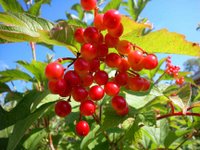Wine Grapes - Part 1
Tuesday, January 30, 2007

Part 1 of the Series
Barbera is grown in many places around the world but is at it's best in northern Italy. In Italy, it makes Barbera d'Asti, Barbera di Alba and Barbera di Monferato, among others. In warmer growing areas it develops high sugar levels and because of this, the alcohol levels in the wine can be too high. It's primary use around the world is as a blending agent to bring increased acidity to the final wine.
Cabernet Franc is a wine grape that is often used in Bordeaux blends to add acidity and aroma. Cabernet Franc is usually used as a minor (10%-15%) component in a blend with other varieties. The only notable exception is at Chateau Cheval Blanc in Saint Emilion. Genetic research indicates that it is the parent of Cabernet Sauvignon. It makes wines that are lighter and fruitier than Cabernet Sauvignon.
Cabernet Sauvignon is the premier wine grape in the world. Cabernet Sauvignon is the dominant grape in the Bordeaux region of France and has spread to every other major growing region. The Cabernet Sauvignon grape produces distinctive wines that are tannic and can have long aging potential. Average aging potential for Cabernet is 5 to 10 years in order to achieve peak flavor. It is usually blended with other varieties to make wines with increased complexity.
When you think of the finest red wines in the world, you often are thinking of wines made with Cabernet Sauvignon. Cabernet Sauvignon is known in some parts of the world by other names including: Petit Cabernet, Sauvignon Rouge, and Vidure.
The Gamay grape variety makes its best wines in the Beaujolais region of France. Because its wines tend to be light, low in alcohol, high in acidity and very fruity, there is small margin for error before it becomes too thin, too light or too acidic. The wines are generally meant to be consumed within two years of bottling. Only the Crus of Beaujolais show much aging potential and none of them extend beyond 10 years. Cherry flavors dominate the nose and taste of young Beaujolais.
A wine named Passe-Tout-Grains is produced in Burgundy and is a blend of Gamay and Pinot Noir.
Technorati Tags : Wine, Grapes, Barbara, Cabernet, Franc, Cabernet, Sauvignon, Gamay

6 Month Cheese Gift
Provolone 3 Lbs

 Follow Me On Twitter
Follow Me On Twitter










